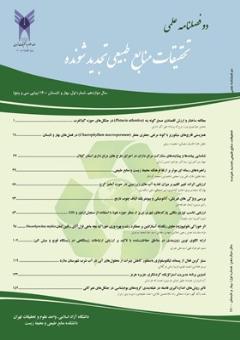به¬کارگیری روش¬های یادگیری ماشین جهت مدل¬سازی کاهش واردات بخار با هدف مدیریت منابع انرژی
احسان شریف آرا 1 , مجید عباسپور 2 , علیرضا سرائی 3
1 - دانشجوی دکتری رشته مهندسی سیستمهای انرژی، دانشکده منابع طبیعی و محیط زیست، واحد علوم و تحقیقات، دانشگاه آزاد اسالمی، تهران، ایران.
2 - استاد دانشگاه صنعتی شریف، دانشکده مهندسی مکانیک، تهران، ایران
3 - استادیار گروه آموزشی مکانیک، واحد تهران جنوب، دانشگاه آزاد اسلامی، تهران، ایران
کلید واژه: پیش¬بینی مصرف بخار, فرصت¬های صرفه¬جویی انرژی, مدل¬سازی انرژی, یادگیری ماشین. ,
چکیده مقاله :
واحدهای تولید اتیلن¬اکساید، اتیلن¬گلایکول یکپارچه، مصرف¬کنندگان مهم حامل¬های انرژی به¬ویژه بخار پرفشار هستند. در این پژوهش، چارچوب مدل¬سازی دقیق برای واردات بخار پرفشار در یک واحد پتروشیمی پیشنهاد گردید. بدین منظور از زبان برنامه¬نویسی پایتون نسخه 3 برای آنالیز داده¬های خام کارکردی روزانه واحد پتروشیمی مورد مطالعه در بازه زمانی کارکرد 5 ساله تحت یک نوع کاتالیست استفاده شد. گزینش¬پذیری کاتالیست و ظرفیت تولید واحد به¬عنوان شاخص¬ها و واردات بخار پرفشار به¬عنوان هدف، جهت مدل¬سازی در نظر گرفته شد. الگوریتم¬های رگرسیون متفاوتی برای گزینش بهترین مدل مورد ارزیابی قرار گرفتند و فراپارامترهای آنها با استفاده از الگوریتم¬های جستجوی شبکه¬ای و بیزین تنظیم گردیدند. روش درخت تصادفی بهترین عملکرد را در شاخص¬های ارزیابی نسبت به سایر روش¬های رگرسیون، اما با بیشترین مدت زمان پردازش به خود اختصاص داد. با در نظر گرفتن مدت زمان پردازش و عملکرد، روش رگرسیون ریج چندجمله¬ای، انتخاب مناسبی تشخیص داده شد. با استفاده از مدل رگرسیون درخت تصادفی تنظیم¬شده، میزان تقریبی 291 تن در روز صرفه¬جویی واردات بخار پر فشار (16 درصد میانگین واردات بخار) معادل با انتشار تقریبی روزانه 38 تن دی¬اکسید¬کربن (37/0 درصد انتشار معادل ظرفیت اسمی تولید بخار تامین¬کننده) حاصل شد. روش پیشنهادی در سیستم مدیریت انرژی واحد مورد مطالعه یکپارچه¬سازی شده است و می¬تواند در دیگر واحد¬های مشابه نیز به¬منظور پایش مداوم رفتار واردات بخار پرفشار بر حسب عملکرد کاتالیست و تولیدات واحد پیاده¬سازی شود.
Integrated Ethylene Oxide/Ethylene Glycol (EO/EG) plants are major energy consumers, particularly in High-Pressure Steam (HPS) usage. This study proposes a data processing and modeling framework for high-accuracy machine learning modeling to predict the HPS import of an EO/EG petrochemical plant. The study employed Python3 and analyzed raw historical data from the plant's DCS, spanning five years of operation under the same EO catalyst. Daily feed and glycol production data were used to calculate catalyst selectivity and the plant's production capacity as models’ input features, while HPS import served as the models’ output target. Various regression algorithms were evaluated to select the best model for this case study, with their hyperparameters tuned using Grid Search and Bayesian Search algorithms. Random forest regression outperformed other methods in R2, MAPE, and RMSE metrics but had the longest training time. Polynomial ridge regression was a suitable choice considering both time consumption and performance. The tuned random forest regression model revealed an approximate 291 Tonne/Day potential for HPS import savings equivalent to 16% of the plant’s average HPS import through enhanced steam import management strategies. Adopting this HPS saving measure would enable the HPS supplier to avert 38 tonnes of CO2 emissions daily equivalent to 0.37% of its nominal HPS generation capacity. Our methodology in this paper can be applied to other EO/EG plants and is currently being integrated into the plant's energy management system, enabling continuous monitoring of steam import behavior relative to catalyst and plant performance.
Ahmadi, A., Noorpoor, A. R., Kani, A. R., Saraei, A. (2021) Modeling and Economic Analysis of MED-TVC Desalination with Allam Power Plant Cycle in Kish Island. Iran. J. Chem. Chem. Eng, 40(6), 1882.
Hauke, J., Kossowski, T. (2011) Comparison of values of Pearson's and Spearman's correlation coefficients on the same sets of data. Quaestiones geographicae, Jun 24;30(2):87-93.
James, G.M., Witten, D., Hastie, T., Tibshirani, R. (2013) An Introduction to Statistical Learning, Page 181.
Mhlanga, D. (2021) Artificial Intelligence in the Industry 4.0, and Its Impact on Poverty, Innovation, Infrastructure Development, and the Sustainable Development Goals: Lessons from Emerging Economies?, Sustainability, vol. 13, no. 5788, pp. 1–16.
Moghadasi, M., Izadyar, N., Moghadasi, M., Ghadamian, H. (2021) Applying machine learning techniques to implement the technical requirements of energy management systems in accordance with ISO 50001: 2018, an industrial case study. Energy Sources, Part A: Recovery, Utilization, and Environmental Effects, Dec 20:1-8.
Moghadasi, M., Ozgoli, H.A., Farhani, F. (2021) Steam consumption prediction of a gas sweetening process with methyldiethanolamine solvent using machine learning approaches. International Journal of Energy Research, Jan;45(1):879-93.
Qian, Y.Y. , Chen, R.L., Chen, J.J., Ding, G.R. (2016) Analysis of the Production and Market of Ethylene Oxide in China. Chem. Ind., 34(2), 46-48.
Rahimpour, M. R., Shayanmehr, M., Nazari, M. (2011) Modeling and Simulation of an Industrial Ethylene Oxide (EO) Reactor Using Artificial Neural Networks (ANN). Industrial & Engineering Chemistry Research, 50(10), 6044-6052.
Sharifara, E. Abbaspour, M., Saraei, A. (2023) Analysis of the high-pressure steam import behaviour of an integrated ethylene oxide/ethylene glycol petrochemical plant under different production scenarios. Canadian Journal of Chemical Engineering. 2023,1. https://doi.org/10.1002/cjce.25143
Shell International Chemicals, Shell Research and Technology Centre Amsterdam, EO/EG Process and Site Support, EO/EG Process Design Package.
Statista. (2023) Retrieved from Statista: https://www.statista.com/statistics/1245260/ethylene-oxide-market-volume-worldwide/.
Zahedi, G. Lohi, A. Mahdi, K. A. (2011) Hybrid Modeling of Ethylene to Ethylene Oxide Heterogeneous Reactor. Fuel Processing Technology, 92(9), 1725-1732.
Zapf, F., Wallek, T. (2022) Case-study of a flowsheet simulation using deep-learning process models for multi-objective optimization of petrochemical production plants. Computers & Chemical Engineering, 162: 107823.
Zendehboudi, S., Rezaei, N., Lohi, A. (2018) Applications of hybrid models in chemical, petroleum, and energy systems: A systematic review. Applied energy, 228: 2539-2566.
Zendehboudi, S., Zahedi, G., Bahadori, A., Lohi, A., Elkamel, A., Chatzis, I. (2014) A dual approach for modelling and optimisation of industrial urea reactor: Smart technique and grey box model. The Canadian Journal of Chemical Engineering, 92.3: 469-485.


